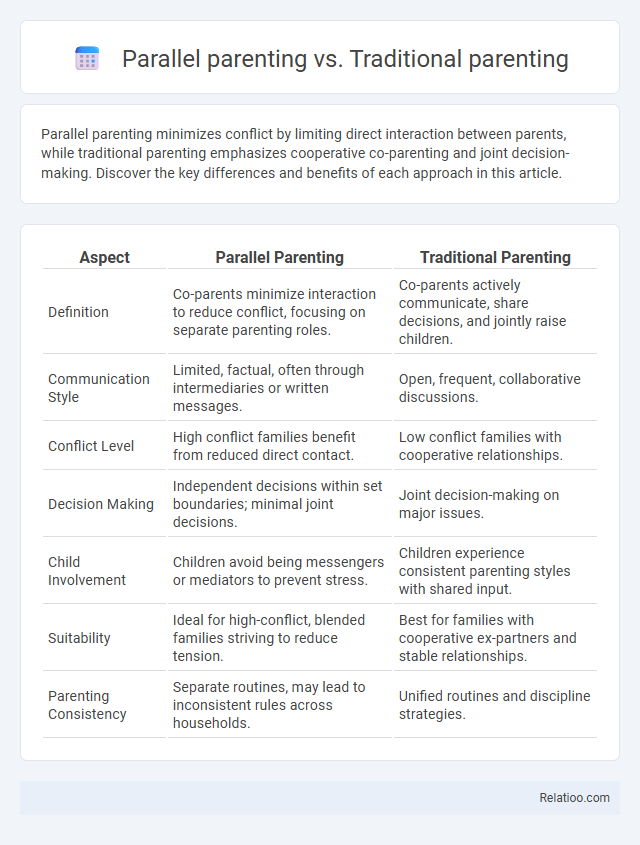Parallel parenting minimizes conflict by limiting direct interaction between parents, while traditional parenting emphasizes cooperative co-parenting and joint decision-making. Discover the key differences and benefits of each approach in this article.
Table of Comparison
| Aspect | Parallel Parenting | Traditional Parenting |
|---|---|---|
| Definition | Co-parents minimize interaction to reduce conflict, focusing on separate parenting roles. | Co-parents actively communicate, share decisions, and jointly raise children. |
| Communication Style | Limited, factual, often through intermediaries or written messages. | Open, frequent, collaborative discussions. |
| Conflict Level | High conflict families benefit from reduced direct contact. | Low conflict families with cooperative relationships. |
| Decision Making | Independent decisions within set boundaries; minimal joint decisions. | Joint decision-making on major issues. |
| Child Involvement | Children avoid being messengers or mediators to prevent stress. | Children experience consistent parenting styles with shared input. |
| Suitability | Ideal for high-conflict, blended families striving to reduce tension. | Best for families with cooperative ex-partners and stable relationships. |
| Parenting Consistency | Separate routines, may lead to inconsistent rules across households. | Unified routines and discipline strategies. |
Understanding Parallel Parenting
Parallel parenting separates parents' roles to minimize conflict, allowing each to make decisions independently while focusing on the child's well-being. Traditional parenting involves more cooperative decision-making, with both parents actively sharing responsibilities and communicating openly. Understanding parallel parenting helps you maintain stability for your child amid high-conflict situations by reducing direct interaction between parents.
Defining Traditional Parenting
Traditional parenting emphasizes clear roles, consistent discipline, and active involvement of both parents in child-rearing, fostering stability and structure. Parallel parenting, in contrast, minimizes direct interaction between parents, focusing on reducing conflict by maintaining separate parenting styles and communication limited to essential information. You should choose a parenting approach that best supports your child's emotional well-being and adapts to the dynamics of your family situation.
Key Differences Between Parallel and Traditional Parenting
Parallel parenting involves minimal direct interaction between parents, focusing on separate responsibilities and communication primarily through written means, which contrasts with traditional parenting's collaborative decision-making and frequent joint interactions. Key differences include the level of cooperation, with parallel parenting suited for high-conflict situations by reducing contact, while traditional parenting emphasizes shared involvement and mutual agreement on child-rearing. Your choice between these approaches depends on the parents' ability to communicate effectively and prioritize the child's stability amidst their relationship dynamics.
Communication Styles in Both Approaches
Parallel parenting emphasizes minimal direct communication to reduce conflict, relying on structured, written exchanges to coordinate parenting responsibilities. Traditional parenting typically involves more collaborative communication, with frequent dialogue and joint decision-making to address your child's needs. Understanding these distinct communication styles helps you choose the approach that best supports effective co-parenting and your family's well-being.
Impact on Child Development
Parallel parenting minimizes conflict by allowing parents to make decisions independently, which can create a stable environment that reduces stress and promotes emotional security in children. Traditional parenting involves cooperative decision-making and joint involvement, fostering consistent discipline and emotional support that benefit social and cognitive development. Comparing both, parallel parenting suits high-conflict situations with reduced communication, while traditional parenting offers more unified guidance, significantly influencing children's behavioral outcomes and overall well-being.
Managing Conflict in Parenting Styles
Managing conflict in parallel parenting centers on minimizing direct contact and using structured communication tools to ensure boundaries are respected, reducing potential clashes. Traditional parenting often involves cooperative decision-making and open dialogue, which can lead to smoother conflict resolution but requires high levels of mutual trust and communication. You can improve co-parenting effectiveness by adopting strategies suited to the specific parenting style, focusing on reducing conflict triggers and prioritizing the child's well-being.
Suitable Situations for Parallel Parenting
Parallel parenting is most suitable in situations where high-conflict parents struggle to communicate effectively, such as after a contentious divorce or separation. Unlike traditional parenting, which works best when parents cooperate and share decision-making, parallel parenting minimizes direct contact, allowing each parent to maintain clear boundaries while focusing on the child's well-being. Your ability to reduce conflict and establish independent roles makes parallel parenting ideal for creating stability in highly adversarial environments.
Advantages and Disadvantages of Each Approach
Traditional parenting offers structured roles and consistent routines, which can foster stability and clear expectations for children but may lead to conflicts if parents have differing philosophies. Parallel parenting minimizes direct interaction, reducing conflict and stress for You and your children, but may create communication gaps and inconsistent discipline. Combining elements from both approaches can balance cooperation and independence, yet requires careful coordination to avoid confusion or mixed messages.
Tips for Transitioning Between Parenting Styles
Transitioning between parallel parenting and traditional parenting requires clear communication, setting firm boundaries, and focusing on the child's best interests to minimize conflict. Establishing consistent routines and utilizing mediation or counseling can facilitate smoother adjustments during the shift. Prioritizing mutual respect and flexibility helps create a cooperative parenting environment despite differing styles.
Choosing the Right Parenting Approach for Your Family
Choosing the right parenting approach depends on your family's unique dynamics, with parallel parenting often preferred in high-conflict situations to minimize direct interaction between parents, ensuring a peaceful environment for children. Traditional parenting emphasizes a cooperative co-parenting style, which works well when parents maintain effective communication and shared decision-making. Evaluating factors such as parental conflict level, communication skills, and the child's needs helps determine whether parallel parenting, traditional parenting, or a hybrid strategy best supports your family's well-being.

Infographic: Parallel parenting vs Traditional parenting
 relatioo.com
relatioo.com